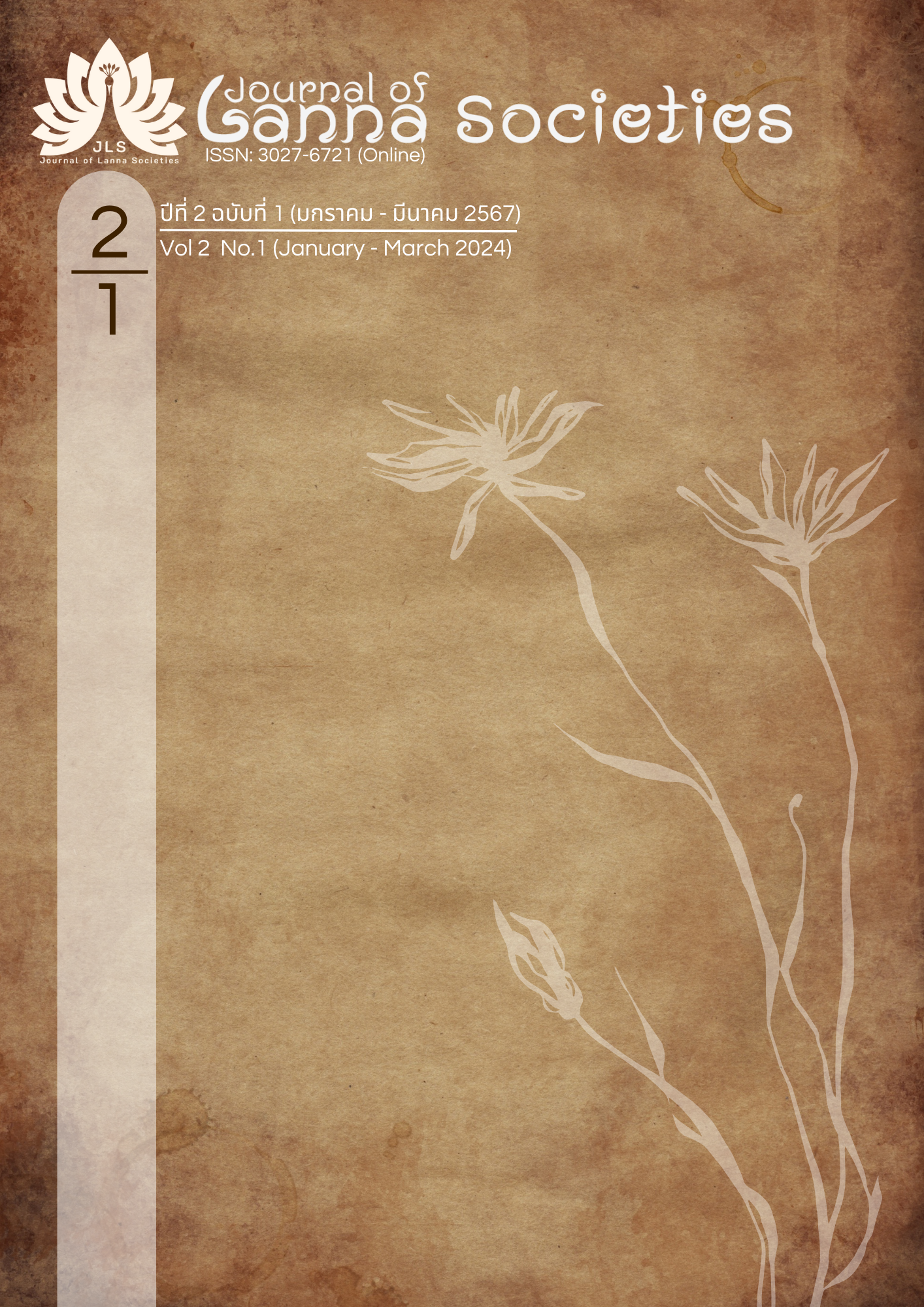Development of Creative Tourism Activity Areas of Nam Cham Sub-district, Muang Phrae District, Phrae Province
Keywords:
Area Development, Creative Area Development, Tourism ActivityAbstract
This article to present the under research “Development of Creative Tourism Activity Areas of Nam Cham Sub-district, Muang Phrae District, Phrae Province”. And the research study has the following objectives: to study the area development and creative tourism activities of Nam Cham Sub-district. Muang Phrae District, Phrae Province. 2) to synthesize area development and creative tourism activities of Nam Cham Subdistrict. Muang Phrae District, Phrae Province; and 3) to present the concept of area development and creative tourism activities of Nam Cham Subdistrict. Muang Phrae District, Phrae Province, is a mixed method research, both qualitative research and action research.
The research Finding
- Study of area development and creative tourism activities the researcher has analyzed Creative tourism context Phae Mueang Phi Forest Park There are legends that have been inherited since the long past. without anyone knowing its true origin but it is said that in this area someone found a treasure and searched for it but did not find the desired target. Found only footprints leading to the area that is presently known as Phae Muang Phi. The agricultural product processing learning center in the area represents the production process that started from the community. Based on local wisdom linked to social progress, there is a self-reliant process. Creative Tourism Resources Phae Mueang Phi Forest Park Occurs about no more than 2 million years caused by the terrain, which is soil. And sandstone is naturally eroded into various shapes. Agricultural Product Processing Learning Center that are distributed in the community It is a small and micro enterprise. Creative tourism activities Phae Mueang Phi Forest Park The activities that take place are activities that have been promoted and supported by both government and private agencies. And there are open for study visits to enhance knowledge of geography. A learning center for processing agricultural products that are distributed in the community. received assistance from government agencies A group of community enterprises that have strong operations and continuous operations.
- Synthesis of area development and creative tourism activities spatial potential There are activities that are the main goal of the community, such as religious traditions. Traditions related to local beliefs in terms of tourism activities, planning, developing areas to allow creative activities to be organized is a process to raise the level of tourism in the community to stimulate the community. In terms of facilities in the area Management suitability of space Sufficiency for the needs of tourists the potential of people in the area Recognizing and acknowledging various information of the village and various news from society in order to adapt and develop with the community to be suitable for the area.
3. Proposal of ideas for area development and creative tourism activities from the synthesis of guidelines for developing areas for organizing creative tourism activities with the 3S process consisting of 1) Storytelling, the study of knowledge about the community foundation is necessary for the development of the area and creating creative tourism activities. It is a process that connects the community in the past. current possibilities and the possibility that will occur in the future. 2) Senses: the study of context elements. The environment of the area for creating interesting creative tourism activities layout of the area to make it attractive for tourists Space design and creative tourism activities create an attractive environment in the area. 3) Sophistication The process of developing areas and creative tourism activities to impress. It brings all processes together to create a brand of an area that is memorable for tourists.
References
กรมทรัพยากรธรณี. (2544). ธรณีวิทยาประเทศไทย. กรุงเทพมหานคร : กรมทรัพยากรธรณี.
คณะกรรมการหมู่บ้าน. (2565). แผนพัฒนาหมู่บ้าน หมู่ที่ 1-4 ตำบลน้ำชำ อำเภอเมืองแพร่ จังหวัดแพร่. เอกสารอัดสำเนา.
ชัชวาลย์ มากสินธ์. (2555). การพัฒนาชนบท. เอกสารประกอบการบรรยาย. จันทบุรี : คณะมนุษยศาสตร์และสังคมศาสตร์ มหาวิทยาลัยราชภัฎรำไพพรรณี.
ณรงค์ เพชรประเสริฐ. (2542). ธุรกิจชุมชน : เส้นทางที่เป็นไปได้. กรุงเทพมหานคร : สำนักงานกองทุนสนับสนุนการวิจัย.
ธิติ กิตติวิทิตคุณ. (2540). ปัจจัยที่มีผลต่อการมีส่วนร่วมของคณะกรรมการหมู่บ้านในการพัฒนา ชนบท : ศึกษาเฉพาะกรณี อำเภอกระทุ่มแบน จังหวัดสมุทรสาคร. วิทยานิพนธ์ศิลศาสตรมหาบัณฑิต สาขาวิชารัฐศาสตร์. คณะรัฐศาสตร์มหาวิทยาลัยรามคำแหง.
ธีรวัลย์ ศิลารัตน์. (2549). การจัดการความรู้ชุมชน. จันทบุรี : คณะมนุษยศาสตร์และสังคมศาสตร์ มหาวิทยาลัยราชภัฎรำไพพรรณี.
นันทนีย์ กมลศิริพิชัยพร. (2560). ทฤษฎีและหลักการพัฒนาชุมชน. เอกสารประกอบการสอนวิชา 2681602 ทฤษฎีและหลักการพัฒนาชุมชน. คณะมนุษยศาสตร์และสังคมศาสตร์ สถาบันราชภัฎรำไพพรรณี.
บัณฑร อ่อนดำและวิริยาน้อยวงศ์ นยางค์. (2533). ยุทธศาสตร์ในการพัฒนาชนบท : ประสบการณ์ประเทศไทย. กรุงเทพมหานคร : มหาวิทยาลัยธรรมศาสตร์.
พจนา สวนศรี. (2546). คู่มือการจัดการท่องเที่ยวโดยชุมชน. กรุงเทพมหานคร : โครงการท่องเที่ยวเพื่อชีวิตและธรรมชาติ.
วิทยาลัยเทคโนโลยีอักษรพัทยา. (2565). กิจกรรมการท่องเที่ยวตามพฤติกรรมนักท่องเที่ยว. [ออนไลน์] http://61.7.151.244/moodle/pluginfile.php/36074/mod_resource/content/2/กิจกรรมการท่องเที่ยวตามพฤติกรรมนักท่องเที่ยว.docx.pdf
วิรัช เตียงหงษากุล. (2529). หลักการพัฒนาชุมชน. กรุงเทพมหานคร : โอเดียนสโตร์.
สนธยา พลศรี. (2547). ทฤษฎีและหลักการพัฒนาชุมชน. พิมพ์ครั้งที่ 5. กรุงเทพมหานคร: โอเดียนสโตร์.
สัญญา สัญญาวิวัฒน์. (2547). ทฤษฎีและกลยุทธ์การพัฒนาสังคม. พิมพ์ครั้งที่ 5. กรุงเทพมหานคร : สำนักพิมพ์แห่งมหาวิทยาลัยจุฬาภรณ์.
สินธุ์ สโรบล. (2546). การท่องเที่ยวโดยชุมชนแนวคิดและประสบการณ์พื้นที่ภาคเหนือ. โครงการประสานงานวิจัยและพัฒนาเครือข่ายการท่องเที่ยวและชุมชน. พิมพ์ครั้งที่ 1. สำนักงานกองทุนสนับสนุนการวิจัย (สกว.) สำนักงานภาค. เชียงใหม่ : วนิดา เพรส.
เสรี พงศ์พิศ. (2552). คู่มือทำวิสาหกิจชุมชน. กรุงเทพมหานคร : พลังปัญญา.
องค์การบริหารการพัฒนาพื้นที่พิเศษเพื่อการท่องเที่ยวอย่างยั่งยืน (องค์การมหาชน) - อพท. (2561). คู่มือกระบวนการพัฒนาและยกระดับกิจกรรมท่องเที่ยวเชิงสร้างสรรค์. กรุงเทพมหานคร : บริษัท บุ๊คพลัส พับลิชชิ่ง จำกัด.
Farahani. H. Z.. and Musa. G. (2012). The relationship between Islamic religiosity and residents’ perceptions of socio-cultural impacts of tourism in Iran: Case studies of Sare’in and Masooleh. Tourism Management.
Ohridska-Olson. R. and Lvanov. S. (2011). Creative tourism business model and its application in Bulgaria. [Online]. http://culturalrealms.typepad.com/files/ creativetourismbm_article_1_lr.pdf.
Ohridska-Olson. R. and Lvanov. S. (2010). Creative tourism business model and its application in Bulgaria. Social Science Research Network.
Raymond. C. (2007). Creative tourism New Zealand. creativity and development. London: Routledge.
Richards C. (2011). Creativity and tourism: the state of the art. Annals of Tourism Research.
Sofield. T.. Guia. J.. and Specht. J. (2017). Organic “folkloric” community driven place-marketing and tourism. Tourism Management.
UNESCO. (2006). Towards sustainable strategies for creative tourism discussion report of the planning meeting for 2006. International Conference on Creative Tourism. New Mexico: Sunstone Press.
Downloads
Published
How to Cite
Issue
Section
License
Copyright (c) 2024 Journal of Lanna Societies

This work is licensed under a Creative Commons Attribution-NonCommercial-NoDerivatives 4.0 International License.





